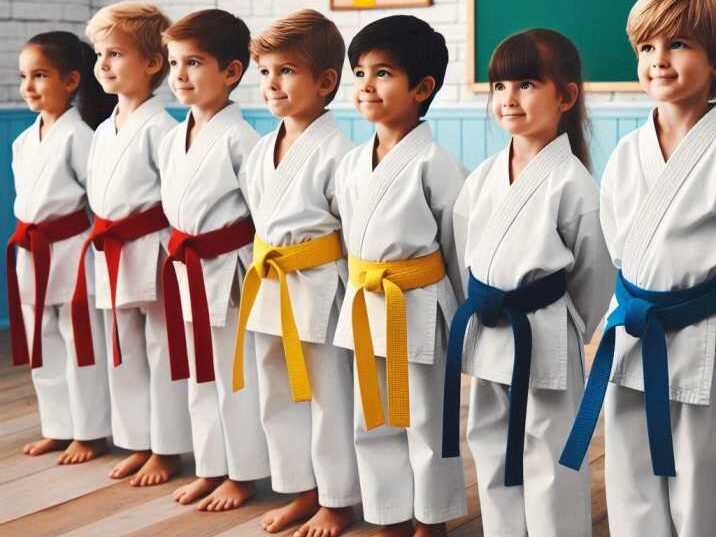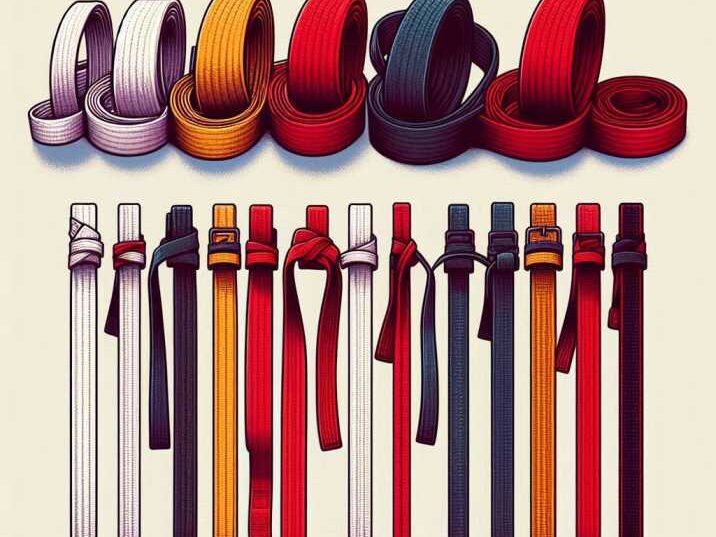Introduction
Table of Contents
Have you ever seen a group of kids wearing different colored belts while practicing karate? Each color tells a special story about their progress, skills, and dedication. In karate, belts are more than just accessories—they represent a journey of growth, learning, and discipline.
In this article, we’ll explore the karate belts in order, what each color means, how students earn them, and why training in karate helps improve focus, confidence, and respect—not just in martial arts, but in everyday life like school and home.

Let’s take a colorful trip through the world of karate belts!
What Are Karate Belts?
The Belt System
The karate belt system is a way to show how much a student has learned. It starts with white for beginners and ends with black for masters. Each belt color is like a step on a staircase, moving students higher as they train more and improve.
Why Belts Are Important
Belts help teachers and students understand each other’s level. They also give students goals to work toward. Earning a new belt means a student has gained new skills and grown stronger—mentally and physically.
How Karate Helps Kids
Karate isn’t just about kicks and punches. It teaches focus, patience, and self-control.
- Improved Focus: Students learn to listen, follow instructions, and concentrate on their moves—skills that help in school.
- Self-Discipline: Training requires regular practice, showing up on time, and respecting others.
- Confidence Building: Earning new belts makes kids feel proud of their hard work.
- Respect for Others: Karate teaches students to respect their teacher (called Sensei) and fellow classmates.
Training requires concentration and discipline, which can translate to improved focus in school and other activities.
Karate Belts in Order and What They Mean
Table: Karate Belts in Order
| Belt Color | Rank | Meaning | Common Age Range | Time to Achieve |
|---|---|---|---|---|
| White | 10th Kyu | Beginning / Purity | 5+ | Immediate (starting level) |
| Yellow | 9th Kyu | Awakening / First Growth | 6+ | 3–6 months |
| Orange | 8th Kyu | Energy / Strength | 6–8 | 3–6 months |
| Green | 7th Kyu | Growth / Stability | 7–9 | 6 months–1 year |
| Blue | 6th Kyu | Calm / Confidence | 8–10 | 6 months–1 year |
| Purple | 5th Kyu | Change / Transition | 9–11 | 6 months–1 year |
| Brown | 4th–2nd Kyu | Maturity / Readiness | 10–13 | 1–2 years |
| Black | 1st Dan+ | Mastery / Deep Knowledge | 13+ | 3+ years |

Exploring Each Belt in Detail
White Belt – The Beginning
The white belt is where every karate student starts. It shows a clean slate, like a blank page, ready to be filled with knowledge. Students learn basic stances, punches, and kicks. This belt reminds students to stay humble and excited to learn. It’s a symbol of a fresh start.
Yellow Belt – The First Light
The yellow belt stands for the first light of the sun. It shows that the student is starting to understand karate basics. Training includes balance practice and simple movements. It’s a time to stay curious and keep learning patiently. This belt encourages growth and focus.
Orange Belt – Building Energy
The orange belt shows that the student is gaining power and confidence. Their moves are faster and more controlled now. Training includes simple combinations and quicker punches. This belt teaches that practice brings power. Students feel more confident in their abilities.
Green Belt – Strong Roots
The green belt represents growth, like a tree with strong roots. Students are more confident and their skills are improving quickly. Training includes advanced blocks and more kata (forms). The lesson is to stay strong and grounded while continuing to improve. It’s a time of solid progress.
Blue Belt – Calm Confidence
The blue belt stands for the sky and a calm mind. Students learn to move smoothly and strike with accuracy. They develop inner confidence and calm focus. The lesson is to show strength without showing off. Students are now becoming role models for others
Purple Belt – A Time of Change
The purple belt is a stage of transition and growth. Students start preparing for the advanced belts. They focus on reflex drills and combination sparring. This belt teaches students to adapt and embrace change. It’s the bridge to higher learning.
Brown Belt – Ready for Mastery
The brown belt means the student is getting close to becoming a black belt. Students start helping others and practice self-discipline. Training includes teaching skills and deeper understanding of karate. The lesson is to stay focused and respectful. It’s almost time for mastery.
Black Belt – The Journey Begins Again
The black belt is not the end—it’s a new beginning. It shows the student has mastered the basics and is ready for advanced learning. Training includes complete techniques, advanced kata, and leadership. The lesson here is: never stop learning. Real growth continues forever.
How Do You Earn a New Belt?
To get a new karate belt, students must take a belt test called a grading test. In this test, students show their karate skills and how much they’ve learned. It’s an exciting way to move up in rank and show hard work and progress.
Performing Kata (Choreographed Patterns)
A kata is a set of karate moves done in a special order, kind of like a dance. It helps students practice their balance, focus, and memory. Each kata gets more difficult as you move up in belts. Judges look for strong stances, sharp moves, and good timing.
Showing Kicks, Blocks, and Strikes
During the test, students must show their kicking, blocking, and striking skills. These moves show how well you can defend yourself or attack in a safe and controlled way. Good form, speed, and accuracy are important. Students often practice these techniques many times before testing.
Demonstrating Discipline and Respect
Karate isn’t just about physical moves—it’s also about discipline and respect. In the test, students must bow, listen carefully, and follow their instructor’s directions. Showing a respectful attitude is just as important as doing good techniques.
How Long Does It Take to Earn Karate Belts?
The time it takes to earn new karate belts depends on your age and how often you practice. Younger kids who train more often may move up faster. Your skills also need to improve with each level. Every karate style (like Shotokan or Goju-Ryu) may have different rules. Most beginners can earn a new belt every 3 to 6 months.
Karate in the United States
Karate became popular in the USA after World War II when soldiers brought it back from Japan. Now, there are thousands of karate schools, or dojos, across the country. Kids, teens, and adults all learn karate for fun, fitness, and self-defense. Today, over 2 million kids in the U.S. take martial arts classes, including karate.
Different Styles, Same System
Most karate styles (like Shotokan, Wado-Ryu, or Kyokushin) use a belt ranking system, though colors may vary a little.
FAQs about Karate Belts
1. What is the first belt in karate?
White belt is the first belt in karate. It shows a student is ready to start learning.
2. How many belts are there in karate?
There are usually 8 to 10 belt colors, ending with the black belt, depending on the karate style.
3. How long does it take to earn a black belt?
It can take about 3 to 5 years of regular training to earn a black belt.
4. What is the hardest belt to earn in karate?
The black belt is the most difficult because it takes years of discipline and skill.
5. Can kids earn a black belt?
Yes! With dedication and practice, kids can earn junior black belts appropriate for their age.

